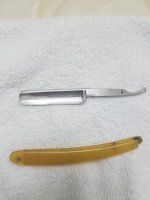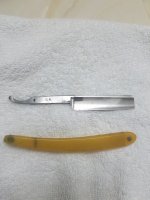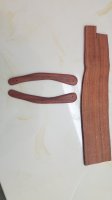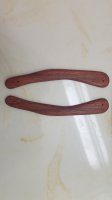I was at my local hobby shop and they had a wood remnants bin that I hunted through but unfortunately the pieces were not labeled. Can anyone identify this wood for me? Is it Purple Heart or Blood Wood or something else? I have several pieces of this wood.

I'm beginning my first complete restoration and I'm planning on making scales.
So far, I've picked up a SR that needs some but not excessive amount of work. I've removed the scales that were cracked and I've begun hand sanding the blade. I'm planning on a 220, 320, 400, 600, 800, 1000, 1200, 1500, 2000 progression. I figure the blade work should take 8 to 10 hours.
I'm doing this entire project by hand.


I'm beginning my first complete restoration and I'm planning on making scales.
So far, I've picked up a SR that needs some but not excessive amount of work. I've removed the scales that were cracked and I've begun hand sanding the blade. I'm planning on a 220, 320, 400, 600, 800, 1000, 1200, 1500, 2000 progression. I figure the blade work should take 8 to 10 hours.
I'm doing this entire project by hand.


Last edited:

